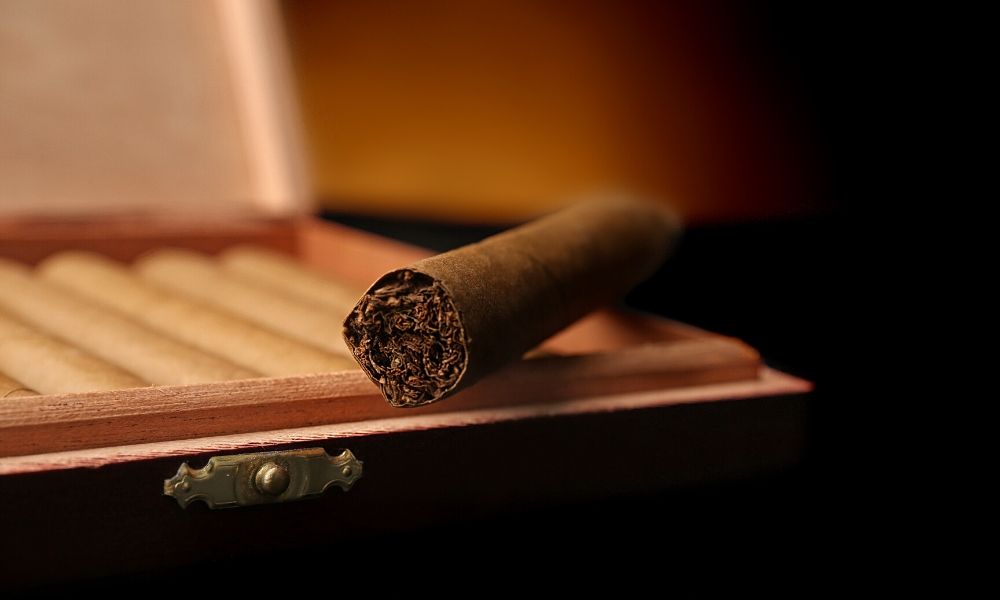Cigar smoking is more than just smoking—it’s an art form. Serious cigar collectors and appreciators know that the lighting of a cigar is just one step in a complex guide of cigar smoking rituals.
Choose a cigar
The first step in lighting a cigar is choosing the right one. Choose your preference—just make sure the quality is up-to-par. If you store your cigar in too dry or too wet of an environment, it may have certain properties that make it difficult to light correctly or remain lit.
Cut the cigar
A bad cut can ruin any cigar, so this step is crucial. Find the spot on your cigar right where the curve ends and begins to straighten out. Many refer to this as the “shoulder” of the cigar and is where you should cut. When cutting, be sure to keep your cigar in a stagnant position and hold it firmly. If it moves or slips during the cutting process, the cut could tear or rip the wrong spot. Cut it in one quick motion to avoid excess tears.
Light the cigar
Now that your cigar is cut and ready, it’s time to add a flame. Don’t use a regular match for your cigar, as they are too short and may even leave your cigar with altered taste. Regular matches use sulfur which, when lit, can leave a distinct flavor that may mask the natural aroma of the cigar. We recommend you use cigar matches, which are significantly longer than a regular match and contain no sulfur. This way your burn will last longer and won’t have a chemical taste.
Pro Tip: To really make your cigar experience your own, invest in personalized cigar matches. This way, you’re getting exactly what you want from a cigar match.
Toast the cigar
After you choose a match, it’s time to toast your cigar. It’s important to not light your cigar or even let it touch the flame. Strike your match to ignite a flame, then hold your cigar over it. Imagine you’re around a campfire and your cigar is a marshmallow you’re trying to turn that perfect golden brown color. You wouldn’t shove the entire marshmallow into the fire—that would ruin it. Instead, hold it carefully and just far enough away from the flame to heat it without a burn.
The goal of toasting your cigar is to create an even and controlled burn of the tobacco. You can achieve an even burn by rotating the cigar and heating each section of it for an equal amount of time. This takes time and patience but is worth the wait. Heat the edges of your cigar until they are ever so lightly blackened and there is a distinct, glowing ring around the entire tip.
Pro Tip: If the flame from your match accidentally comes into contact with your cigar, don’t panic. Swiftly move the cigar out of the flame and assess the damage. Even a mildly severe burn won’t ruin a cigar entirely. The most important thing is an even burn—if you catch the mistake quickly enough. you can correct it.
Test the cigar
Once your cigar has the distinct glowing ring and lightly blackened edges, it’s time to test it. Take anywhere from one to three puffs of your cigar. Monitor the taste, how it feels, and if you think the burn was effective. After your initial puffs, turn the cigar around. Blow very gently onto the foot of your cigar. This is how you check for an even and effective burn.
If your cigar isn’t burning the way you’d like or is burning only in certain spots, now is the time to correct it. Grab another cigar match from your book and heat the less heated areas to even out the burn. Even burns are important because uneven burns can lead to many problems—some that can even ruin your cigar.
Common issues and their solutions
Canoeing
Canoeing is typically a result of an improper light but can also be a sign of a bad cigar or poor storing conditions. The most common thing that causes a cigar to canoe is allowing an uneven burn to go uncorrected.
Canoeing is when the cigar burns only at the top, leaving the bottom intact and unlit. If you catch canoeing right away, you can fix it and, in turn, save the cigar. At the first signs, stop smoking and grab another match. Light it and focus the heat only on the bottom part of your cigar. This is an attempt to even out the burn and allows the bottom to catch up to the top.
Tunneling
Tunneling happens when the cigar’s wrapper cools or loses heat even though your filter continues to burn. This typically happens when there is too much time between your puffs. Keep it consistent and pay close attention to your cigar when you take longer periods in between puffs.
Tunneling is when the cigar develops a hole (or tunnel) and thus burns unevenly. The fix is quite simple—just grab another cigar match, light it, and heat the wrapper. Avoid having the heat come in contact with your cigar’s filter.If you come across a hole larger than one centimeter, you may need to recut or even dispose of your cigar. This is why it’s so important to stay alert and monitor your cigar during the smoking process.
Coning
If your cigar is coning, it’s time to slow down. A cigar cones when the smoker puffs too frequently. It causes the cigar’s wrapper to burn much quicker than the tobacco, creating a cone-like shape. To monitor this, pay attention to how many puffs you take and gauge how long it typically takes you to smoke the type of cigar you have. If you notice it’s going by a lot faster than normal, inspect the foot of the cigar for signs of problems.
If you catch it early enough, you can fix coning. Set the cigar aside or don’t puff it for a minute or so to allow the tobacco to catch up in the burning process to the wrapper.


